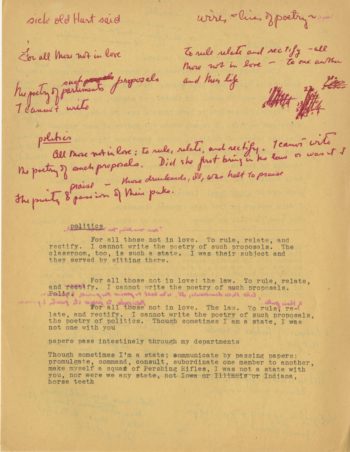Readers on The William H. Gass Reader
On the occasion of the publication of The William H. Gass Reader, we asked two writers and Gass aficionados about how his archive here at Special Collections helped shape their research into his celebrated essays and stories.
Gass’s literary output was impressive– he published seventeen books in his lifetime and hundreds of articles. While The William H. Gass Reader cannot physically contain all he has done, it features many of his most revered works, or excerpts from them, offering a condensed look at his life as a writer and thinker.
Assembled by Gass himself and published less than a year after his death, there is an air of finality to this collection, of a literary legend’s last, summative statement to the world. For Gass fans, who think of him as famously loyal to the revision process–a writer who never stopped tinkering with his work–The Reader is a bittersweet farewell.

Zachary Fine, a literary critic, visited Special Collections in early fall 2019 in order to understand Gass’s process of revision. He said that “Gass wrote beautifully about re-writing—especially in ‘The Soul Inside the Sentence’—and I felt that any effort to understand his work would only benefit from seeing his revision process. He claimed that he was not naturally a great writer, and so I was curious about the strenuous effort, the strain, to be one. His finished and published work, for all of its eccentricities, is so polished and perfectly weighted that it’s impossible to get a sense of the labor behind the words…. I’m almost addicted to that paradox in his work: the amount of strain it required and the quality of inevitable genius it still somehow exudes.”

Ted Morrissey, author of two books of scholarship and two books of fiction, credits Gass’s prolific, though slow progress, to his fastidious work-style. “Gass always maintained that he worked very, very slowly, which was the main reason it took him nearly 30 years to write The Tunnel, a novel which he began to write in the mid-sixties but wasn’t published in whole until 1995, and we can see via the copious early drafts, generally composed on a manual typewriter, how much effort he put into writing and revising his prose. In some cases there may be dozens of drafts of a single paragraph as Gass worked to get the words just right.”

Of course, The Reader is unable to capture the process of Gass’s writing (see the Gass manuscripts and digital exhibition for that), or include everyone’s favorites (see On Being Blue and Willie Master’s Lonesome Wife, for example). But for those new to Gass, The Reader serves as a much-needed introduction to one of the twentieth century’s most prolific writers, and for those already well versed in his oeuvre, it serves as a handy (though heavy) way to dip into those musical sentences and memorable narrators on a regular basis.
For more takes on the release of The William H. Gass Reader and on the legacy of “the Master” himself, watch this recent round-table discussion between Lisa Sharkey, Jan Garden Castro, Garth Hallberg, Joel Minor, and Sam Sacks. You can also watch it on our YouTube channel.
